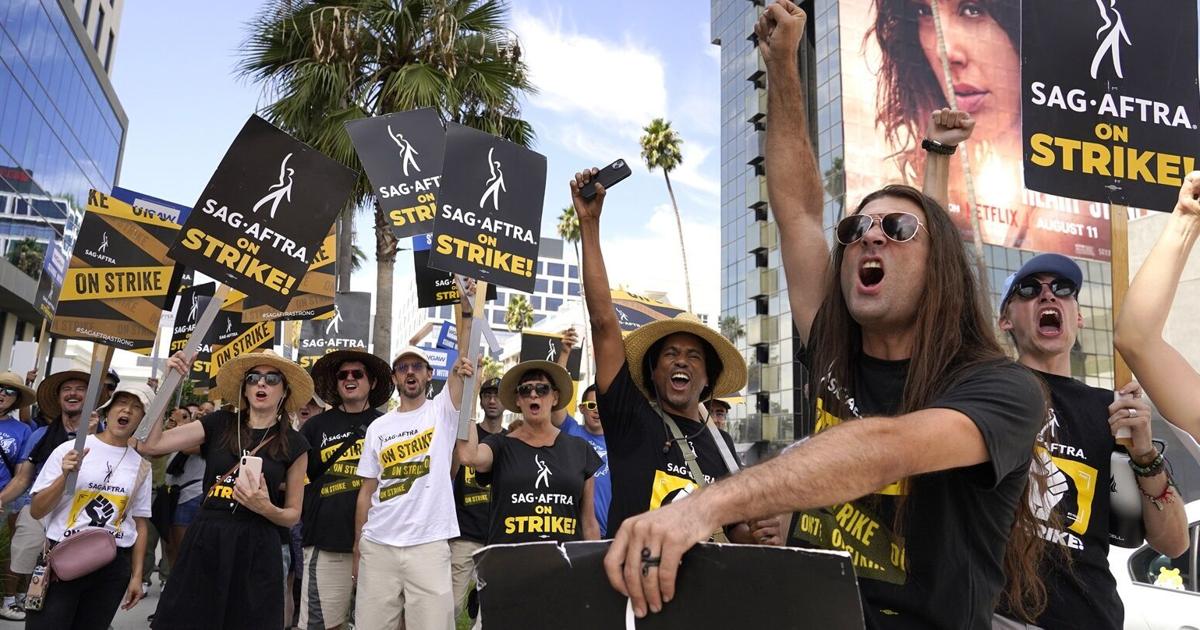NEW YORK — Hollywood’s months of labor unrest are coming to an end, but the post-strike landscape that awaits actors and writers may be far from happily-ever-after.
The film and television industry could rightly celebrate the conclusion last week of a bruising, protracted work stoppage that began in May when the Writers Guild hit the picket lines and gathered more force when Screen Actors Guild-American Federation of Television and Radio Artists members walked out in mid-July.
The strikes were historic in their length and cost, causing an estimated $6 billion in economic loss and leaving hundreds of thousands out of work. As Hollywood on Thursday began rushing back to production and stars again hit red carpets, many were surely still nursing wounds from a bitter feud with the studios, even after a deal that the guild says won actors a hefty boost to minimum pay and protections over the use of artificial intelligence.
People are also reading…
SAG-AFTRA’s board voted to approve the contract Friday afternoon.
But as actors swap their picket signs for audition sides and call sheets, they’ll be returning to an industry still in the midst of painful transformation and streaming upheaval.
The strikes were prompted largely by the streaming wars, a digital land-rush to populate platforms like Disney+ and HBO Max (now just “Max”) with enough content to rival Netflix. That helter-skelter transition threw much of the economics of entertainment out of whack. One of the most contentious issues of SAG-AFTRA’s negotiations with the studios was the union’s attempt to win a percentage — 1 or 2% — of streaming revenue, to replace lost residuals. In the end, the actors accepted a bonus tied to viewership.
But even before the strike, every studio was reexamining its streaming strategy. After several years of rampant green lights, most are pulling back, looking to make fewer series and movies, cutting staff and desperately seeking a path toward profitability. Wall Street, no longer enamored with subscriber numbers, wants to see profit, too.
The aftermath of the strike may look less like a party and more like a streaming hangover.
“The streaming business is completely screwed up. There’s too much content and nobody seems to be able to make any profit from it,” says Jonathan Taplin, director emeritus of the USC Annenberg Innovation Lab and author of “The End of Reality: How Four Billionaires are Selling a Fantasy Future of the Metaverse, Mars, and Crypto.”
Both strikes, Taplin says, were successful because the guilds gained bulwarks against potential decimation by artificial intelligence. But the road ahead, during which he expects linear television to collapse and some streaming services to go out of business, will be strained.
“The whole business is in a complete uproar,” says Taplin. “It will sort itself out in the next three to five years, but it’s going to be painful.”
This is the world that awaits actors as they rush back to sets: Better pay but fewer jobs and intense competition. Puck’s Matt Belloni wrote: “What should be a time of relief and celebration in Hollywood is more akin to what soldiers experience in countless war movies — the horrors of battle give way to the equally grim reality of the new world for which they fought.”
Still, the strikes recalibrated power in Hollywood, winning gains for actors and writers and rallying union support throughout the industry. More battles loom. The contract for International Alliance of Theatrical Stage Employees, which represents crew members, expires at the end of July.
Meanwhile, for months studios have signaled they’re downsizing. Lastweek, Walt Disney Co. CEO Bob Iger in an earnings call where he touted the financial benefits of more than 8,000 job cuts, said the company is focused on consolidating: “Make less, focus more on quality.”
“At the time the pandemic hit, we were leaning into a huge increase in how much we were making,” Iger said. “And I’ve always felt that quantity can be actually a negative when it comes to quality. And I think that’s exactly what happened. We lost some focus.”
Netflix, which earlier set its sights on a new original movie every week, has said it’s now aiming for about half that. Hulu, which Disney plans to bundle with Disney+ after acquiring Comcast’s stake, is slimming down. Peacock lost $2.8 billion this year, Comcast has said; it announced layoffs to its marketing department Thursday.
Warner Bros. Discovery Chief Executive David Zaslav has taken drastic steps to get Max in order while the studio post-merger carries $43 billion in debt.
“This is a generational disruption we’re going through,” Zaslav said Wednesday. “Going through that with a streaming service that’s losing billions of dollars is really, really difficult to go on offense.”
Cancellations have grown more commonplace as streamers get more selective. Due in part to the strikes, series production will dip for the first time in years in 2023 after reaching an all-time high last year, when 599 original series were made. Peak TV, some say , is over.
But there are still huge amounts of money being thrown around. Apple Studios, for one, is behind two of the fall’s biggest budget films in Martin Scorsese’s “Killers of the Flower Moon” and Ridley Scott’s “Napoleon.”
What the Hollywood strikes tell us about the state of unions in the US
What the Hollywood strikes tell us about the state of unions in the US

To hear Hollywood talk about the current moment in labor history, American workers stand on a precipice.
“We are all going to be in jeopardy of being replaced by machines and big business, who care more about Wall Street than you and your family,” actress and Screen Actors Guild and American Federation of Television and Radio Artists president Fran Drescher told members of the media gathered for a SAG-AFTRA news conference in mid-July 2023.
Against the backdrop of new technology that carries the potential to eliminate jobs and wages that don’t keep up with inflation, more Americans than ever find themselves sympathizing with unions. Public approval of unions reached a modern high over the past year with at least 7 in 10 Americans (71%) thinking favorably of unions compared with 68% of Americans in 2021.
The trend has been on the rise since 2010, and the increased enthusiasm for organized labor is beginning to manifest itself in newly formed unions in recent years. The number of elections held in U.S. workplaces to decide whether workers can collectively bargain with their employer rose 51% in 2022 compared to the year before, according to a Stacker analysis of National Labor Relations Board case data. Still, union membership rates nationwide are far from their golden days, and experts say a serious boost may require more than just enthusiasm.
The 160,000 workers represented by the SAG-AFTRA union voted to authorize a strike in July. The historic vote marked only the second time in history that actors and writers have gone on strike simultaneously. The Writers Guild of America, representing 11,500 TV and film writers, authorized a strike two months prior.
The reasons for the strike are disagreements between writers and actors and their big studio and network counterparts who own the distribution channels for their work. The workers warn that studios want to use workers’ likeness and past writing to make artificial intelligence-generated entertainment at low cost.
Beyond Hollywood, AI is being put to work reducing costs in other industries. Today’s generative AI can automate software processes and perform white-collar jobs typically performed by entry-level workers. A June 2023 Business Wire survey illustrates how the emerging technology has put the interest of workers at odds with their employers. According to software provider Qualtrics, 64% of executives surveyed described AI as “exciting,” but only 39% of full-time employees surveyed felt the same way. And about as many employees as executives who are excited about AI expect job loss of some kind.

Union support reaches levels last seen when Ronald Reagan led striking Hollywood actors

The last time working conditions were severe enough to warrant both actors and writers striking at the same time was more than 60 years ago. In 1960, Ronald Reagan had yet to make his run for the White House and was leading the strike as an actor and SAG’s president.
Though technology was less in focus in 1960, workers then, much like today, were motivated to strike by a perception of unfair negotiations over pay. Actors and writers won beneficial residual pay for movies they acted in because of that strike. The actors’ strike lasted six weeks—while the writers stopped work for 21 weeks—before reaching an agreement with the Alliance of Motion Picture and Television Producers representing the movie studios and networks.
In the following decades, Reagan would be elected president with the support of the business community. During his presidency, he took action to stymie the power of workers unions, most famously when he broke the air traffic controllers’ strike. Labor’s favor with the public began its precipitous decline.
Union drives grow more effective

The frequency with which workers have been able to win union representation in the workplace has increased since the Great Recession, when perceptions of organized labor had reached rock bottom.
It’s important to note that Stacker’s analysis groups case data by the calendar year ending in December and will differ slightly from official NLRB numbers, which adhere to a federal budget calendar ending in October.
Clashes between workers and employers rising

Workers mounted nearly 24 large work stoppages last year—on par with the number conducted before the COVID-19 pandemic. A work stoppage, or strike, typically happens after a majority of workers in the union vote to authorize it, but workers’ right to strike does not require union representation.
Workers can initiate a strike legally for economic reasons, like seeking fair wages or fewer work hours. Or they can legally strike in response to a perceived “unfair labor practice,” which describes when employers run afoul of the National Labor Relations Act.
Several of the most headline-making strikes in recent years have occurred in California, where the cost of living is among the highest in the country, a trend that continues into 2023. It’s not just Hollywood actors—janitors and teachers are also flexing their right to strike. West Coast states—including California, Oregon, Washington, and even Alaska—have the highest percentages of unionized workers behind New York, where 1 in 5 workers belong to a union.
Union membership still below prepandemic levels

Nationwide, however, union membership has been in freefall for decades. In 1983, 1 in 5 workers were union members. Today, that figure is just 10%—the lowest on record, according to the Bureau of Labor Statistics. Even though the raw numbers of union members have increased with time, employers continuously add nonunion jobs that dilute the membership rate.
Union election wins for workers also don’t always foretell new labor strength, as the election is often just the first step in the arduous process of establishing a working agreement between employees and the employer.
After winning recognition, new unions are granted the right to formally negotiate with employers who often use stall tactics to keep the union from ever getting its first written working contract. Almost half of all union drives result in new unions, but only about half of those new unions are even successful in winning an initial contract after that.
Academics have argued that without stronger penalties for employers who violate labor law, such as those included in the failed Protecting the Right to Organize Act legislation, it will continue to be burdensome for workers to successfully negotiate working conditions with their employers. The act failed to make its way through Congress and into law in 2020 and 2021, and it faces steep opposition in 2023, including from business interests like the Society for Human Resource Management and Republican politicians in the House of Representatives who argue it would give workers too much power.
For established, well-organized unions like SAG-AFTRA, WGA, and those in other industries like the Teamsters’ delivery workers unions, the enthusiasm of this year’s so-called “hot labor summer” could provide cover to other workers looking to level the playing field the only way they can control—by walking off the job.
Story editing by Ashleigh Graf. Copy editing by Paris Close.








